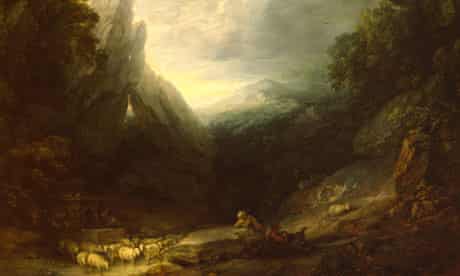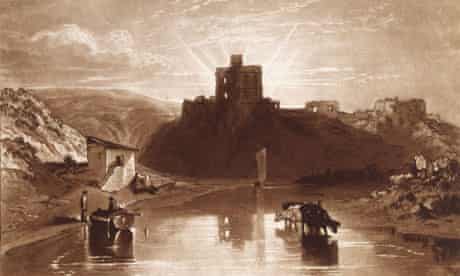What can draw you into a picture of a prairie landscape?
A ccording to traditional art history, before the mid-18th century the British but couldn't paint. The all-time artists at work on these shores were all foreign, from Holbein and Van Dyck to Orazio Gentileschi and Peter Lely. In this account, the first original native painter was Hogarth, and the first genre to exist distinctively British was mural painting. Fifty-fifty in this we were no better than we ought to be: mural was a lowly genre, some way below the salt, while history painting with its moral and didactic qualities lorded it at the caput of the tabular array. Every bit Sir Joshua Reynolds, the human who sought higher up all others to put British painting on a par with the remainder of Europe, said: "A mere copier of nature can never produce anything great."
Reynolds'due south fiefdom, the Royal Academy, is at present putting on an exhibition that examines the origins and evolution of the British landscape tradition and why information technology took such a hold on the public imagination. The 120 works in Constable, Turner, Gainsborough and the Making of Landscape take all been drawn from the academy's ain voluminous collection, making it the starting time fully habitation-grown show at Burlington Business firm for 50 years.
There is nothing especially new near either the theme or the participants. The birth of the Georgian landscape in art, literature and gardening has been minutely examined down the years. This exhibition's three big names are all familiar; indeed, after Turner and Claude at the National Gallery and Turner, Monet and Twombly at Tate Liverpool, this is the 3rd bear witness this year to present Turner in visitor with other artists – information technology's equally if he is no longer safe to be allow out on his own. Nor was the Majestic Academy always so cracking on its headline acts. While Turner, from child prodigy until his death, was an academician through and through, both Gainsborough and Lawman had fractious relationships with the establishment. The latter in one case had to sit silently every bit a member of the RA rejected 1 of his paintings because it was "a nasty light-green thing". He was elected a full academician only aged 53 and even so past just i vote.
Where this exhibition seeks to differentiate itself is in looking at the role that prints played in popularising the genre and branding the painters. It as well stresses how the sense of taste for landscape was present before there were painters to satisfy information technology. Grand Tourists had brought home numerous works by the great practitioners of continental Europe Nicolas Poussin, his blood brother-in-constabulary Gaspard Dughet, Salvator Rosa and Claude Lorrain. The poet James Thomson lauded their dissimilar styles – "What always Lorrain light-touched with softening hue, / Or savage Rosa dashed, or learned Poussin drew" – and their effect on British painters was profound. Constable, Turner and Gainsborough all studied Claude and his landscapes of the Roman campagna in particular; Constable, indeed, became so besotted that he once wrote to his married woman: "I do not wonder at your being jealous of Claude – if anything could come between our love it is him." Turner, meanwhile, ancestral numerous of his paintings to the nation on condition that two should be hung alongside a pair of Claudes in the National Gallery.
So it was through emulation rather than a burgeoning of native spirit that what another poet, William Cowper, described equally "Italian light on English walls" came to be painted. When it did, it appeared in several varieties. The nascency of British mural painting was heralded past an involvement in aesthetic theory as well. In 1757 Edmund Burke published A Philosophical Inquiry into the Origin of our Ideas of the Sublime and Beautiful, which, in turn, towards the finish of the century, led to the theory of the picturesque championed by William Gilpin. For landscape artists, the sublime was substantially the evocation of awe and terror, the beautiful meant soft and aesthetically pleasing, while the picturesque – literally "in the manner of a moving picture" – was divers as irregular, ragged and asymmetrical.
These categorisations helped to spread a new appreciation of the British countryside, and Wales, the Lake District and Scotland became crowded with tourists in search of picturesque views. The situation intensified when the advent of the revolutionary wars in France closed off mainland Europe. Early on adopters who helped to reveal the potential of the British landscape included Richard Wilson, who had lived in Italy and brought his agreement of classical landscape painting to bear on his native land, and Thomas Smith of Derby, whose pictures of the Tiptop District showed undreamed-of drama.

If there was one picture that was the fons et origo of the British school it was Wilson's The Devastation of Niobe and her Children, painted in 1760. It showed the girl of Tantalus suffering the punishment of the gods for boasting nearly the dazzler and number of her children. In a rocky coastal landscape with the sky split by lightning and under a storm-shaken tree, Apollo and Diana pick off their mortal victims with their arrows. The painting, and the impress after it of extraordinary quality past William Woollett, caused a sensation: this was no topographical piece but a noble if fictitious landscape, which, when combined with a mythological scene that together had a moral, emotional and intellectual message. It was landscape painting with aspirations. Wilson was to die in beverage and in poverty, merely his case didn't. Neither did Woollett's; his technical experimentation won him both coin and praise, even among the French. Like Wilson, he served every bit an inspiration to succeeding generations of engravers.
It was against this groundwork that Gainsborough, Turner and Constable painted, and each took a different approach. Gainsborough (1727-88) painted the sedate countryside of his native Suffolk, treating it in more in the modest, naturalistic manner of 17th-century Dutch artists than that of the French and Italians. Although he painted existent places, landscapes were a class of release. He wrote to a friend that: "'I'm sick of Portraits and wish very much to take my Viol da Gam and walk off to some sweet Village where I can paint Landskips …" And when he couldn't, he simply fabricated them up using trivial mises-en-scène of mirrors for water, coal for rocks, moss for greenery and broccoli for trees and finessed them into woodland settings.
Constable (1776-1837), his fellow East Anglian, was more thoroughgoing. For all his adoration for Claude he refused to be always "running after pictures and seeking the truth at second mitt". He painted the places he loved best and because he believed that no two leaves of a tree were e'er "alike since the creation of the globe" his method was ane of minute observation. His blood-and-soil approach did non endear him to the RA, which objected to his refusal to "elevate" his bailiwick thing; but the work he submitted on somewhen being elected, Boat Passing a Lock, shows not just his fidelity to the changing appearance of nature merely his emotional attachment to the countryside of his birth.
Turner (1775-1851) too started as a topographer before picking up his Claudean inheritance. Where Gainsborough called figures in landscape paintings "a piddling concern for the center", Turner saw them as intrinsic to his pictures' meaning, whether it be Hannibal and his soldiers crossing the Alps in a snowstorm or, in his brooding diploma slice for the RA, Dolbadern Castle (1800), the medieval Welsh prince Owain Goch ap Gruffydd. While Constable never left England, Turner scoured Italian republic, France and Switzerland for grand landscapes that he could treat in the traditional classicising manner – a foreground tree framing some human being figures and a middle distance with, say, a river or a castle for interest, and a afar blue horizon. Even at his nearly idealising, however, as he sought to impart nobility of sentiment to his scenes, he kept a real mural at the heart of the picture.
It is one of the asides of this exhibition that Turner, the nearly technically radical of the three painters, was also the virtually traditional and that he was never the abstruse expressionist avant la lettre he is often now made out to be. As if to prove the indicate about his establishment mentality, the exhibition also includes Turner'due south well-used line-fishing rod: revolution and angling don't seem natural bedfellows. The rivers that appear so often in his pictures he knew intimately from a bankside position, when he wasn't drawing them he was fishing them (his regular companion was the architect Sir John Soane).
The three men'due south attitudes towards the prints that advertised their names differed, too. Although Gainsborough never sold a impress from his own hand he was technologically curious, happily experimenting with the differences between etching, soft-ground etching and aquatint equally means of reproducing the effects of drawing or painting. Prints as a marketable commodity were of less interest to him.
Turner and Constable, on the other hand, took them very seriously. Constable struck upward a shut relationship with his master printmaker, David Lucas, whose mezzotints of the painter'south work were published as Diverse Subjects of Landscape, Feature of English Scenery (1830–32). So skilled was Lucas at translating colour into light and shade – the chiaroscuro that Constable called "that power which creates space; we observe it everywhere and at all times in nature" – that Constable claimed Lucas achieved the furnishings he himself wanted to but couldn't manage.

Turner's printmaking centred on his Liber Studiorum (1807-19), a book of a projected 100 plates to demonstrate the expressive power of mural (Constable grumpily and jealously referred to it as the "Liber Stupidorum"); the title was inspired by Claude's similar project, the Liber Veritatis. He divided his plates into categories such every bit "Historical", "Pastoral" and "Marine" and micromanaged his engravers to such an extent that when dissatisfied with their work he both engraved and mezzotinted some of the plates himself. During the course of this and subsequent projects, he trained a cadre of British printmakers skilled in representing the effects of paint and watercolour in line and tone that was the envy of Europe.
This intense piffling exhibition may be devoid of blockbusters but it is rich: the nascence of the artist entrepreneur, the end of the established method of patronage and the democratisation of the landscape are among the themes hiding amongst the more natural beauties of Gainsborough, Constable and Turner'southward wood, fields and hills.
Source: https://www.theguardian.com/artanddesign/2012/nov/23/constable-turner-gainsborough-making-landscape
Posted by: khangwartan.blogspot.com


0 Response to "What can draw you into a picture of a prairie landscape?"
Post a Comment